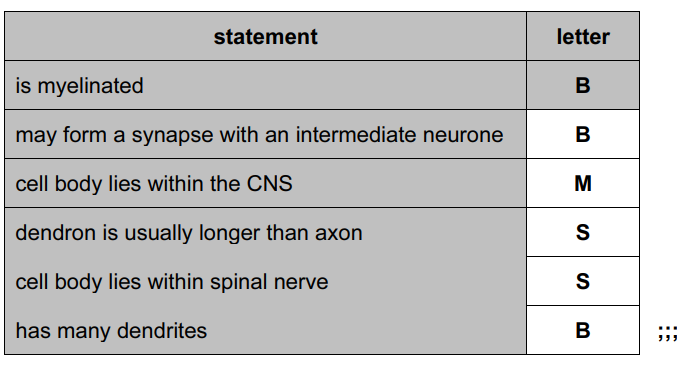Question
Scorpions are predatory arthropods. They have a pair of grasping claws at the front of their bodies and a tail with a stinger. The stinger is used to inject venom into their prey to cause paralysis.
Fig. 6.1 shows a scorpion.

(a) Scorpion venom contains two active components:
- a toxin that affects ion channels at synapses of the nervous system of their prey
- an inhibitor of an enzyme found at these synapses.
For each component of the venom, suggest and explain one way in which it may stop the correct functioning of the synapse.[4]
toxin
inhibitor
(b) Scorpions stand very still on the sand. Moving prey will disturb grains of sand, and scorpions are able to detect this movement using sensory organs, known as slit hairs, at the tips of their legs. Some of the cells of a slit hair act as sensory receptors.
(i) State the role of a sensory receptor.[1]
(ii) When a slit hair is bent by the movement of the sand the potential difference across the cell surface membranes of the slit hair cells becomes more positive inside compared to the outside.
State the name given to the initial change in potential difference that may lead to an action potential.[1]
(iii) Action potentials may then be sent by the cells in the slit hairs to the central nervous system (CNS) of the scorpion.
Explain how the scorpion is able to distinguish between a small and a large movement of sand.[2] [Total: 8]
Answer/Explanation
Ans:
6 (a) toxin (max 2)
1 calcium ions do not enter presynaptic, neurone/ knob ;
2 ACh / neurotransmitter, not released into synaptic cleft ;
3 sodium ions do not enter, neurone/ axon ;
4 no depolarisation of (postsynaptic) membrane/
no action potentials in (postsynaptic) neurone ;
inhibitor (max 2)
5 blocks / binds to, acetylcholinesterase ;
6 ACh / neurotransmitter, remains attached to receptors ;
7 continuous, depolarisation of postsynaptic membrane/
action potentials in postsynaptic neurone ;
8 stops recycling of ACh/ neurotransmitter/AW ;
(b) (i) convert/ transduce, stimulus into a, nerve/ electrical, impulse ; A named stimulus
(ii) receptor/ generator, potential ;
(iii) 1 idea that the larger the intensity of stimulus
the greater the frequency of action potentials ;
2 further detail ; e.g. ref. to all-or-nothing law/ all action potentials have same p.d.
3 may involve more, receptors / neurones ;
Question
(a) The passage below outlines how sensory receptors work.
Complete the passage by using the most appropriate scientific term(s).
A sensory receptor cell responds to a stimulus by opening ion ___________ in its cell surface membrane. Sodium ions flood into the cell causing the membrane to become ___________. This is called the ___________ potential. If this potential is
large enough to reach a ___________ then an action potential is transmitted to the central nervous system. An increase in the strength of the stimulus will result in an increase in the ___________ of action potentials transmitted. [5]
(b) Describe how an action potential is transmitted along a sensory neurone in a mammal.[5] [Total: 10]
Answer/Explanation
Ans:
6 (a) channels ; I voltage-gated
depolarised ; A positive inside
receptor/ generator ;
threshold ;
frequency ; A number per second/rate R speed
(b) action potential stimulates neighbouring area of membrane ; AW
Na+, moves sideways / attracted to areas at resting potential ; A local circuit causes, Na+ ion channels to open/ 2nd depolarisation ;
(transmission) in one direction due to, hyperpolarisation/refractory period ;
myelin sheath/Schwann cell ;
sheath insulates, axon/ dendron/ neurone ;
depolarisation/ action potential, only at nodes of Ranvier/ unmyelinated part ; ora
saltatory conduction/action potential ‘jumps’ from node to node ;
Question
(a) Neurones transmit impulses from one part of a mammal’s body to another.
The table contains statements that refer to motor and sensory neurones.
Complete the table, indicating with the letters M, S or B, whether each statement applies to:
- motor neurones only (M)
- sensory neurones only (S)
- both motor and sensory neurones (B).
The first one has been done for you.[3]

(b) A synapse is a junction between two or more neurones.
Describe how an action potential arriving at a presynaptic membrane of a neurone can result in the depolarisation of the membrane of a post-synaptic neurone.[5]
(c) Acetylcholinesterase is an enzyme found in the synaptic cleft.
Outline the role of acetylcholinesterase.[2] [Total: 10]
Answer/Explanation
Ans:
6 (a)

all correct = 3 marks
3/4 correct = 2 marks
1/2 correct = 1 mark
(b) 1 Ca(2+) channels open (in presynaptic membrane/presynaptic knob) ;
2 Ca2+ enter (pre)synaptic knob ;
3 vesicles contain, neurotransmitter/ACh ;
4 (vesicles) move towards/fuse with, presynaptic membrane ;
5 (ACh/neurotransmitter) released/exocytosis ;
6 (ACh/neurotransmitter) diffuses (across cleft) ;
7 binds to receptors on postsynaptic membrane ;
8 Na(+) channels open ;
9 Na+ enters post-synaptic neurone ;
penalise lack of mention of ions in mp2 and 9 once only
(c) hydrolyses/breaks down, ACh ;
stops continuous production of action potentials (in post-synaptic neurone) ;
